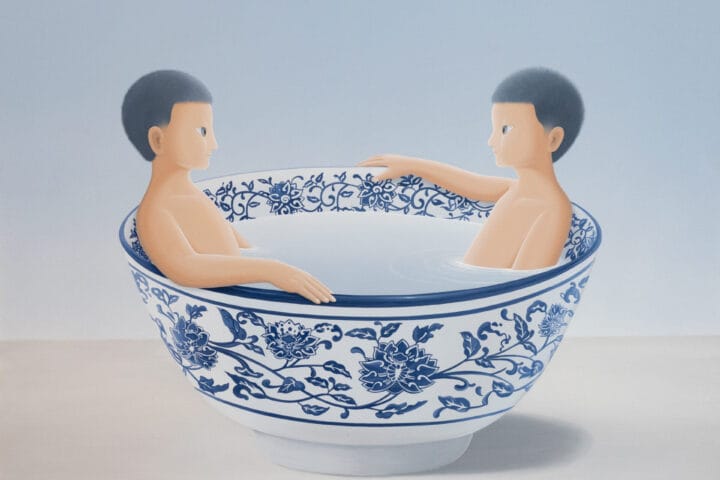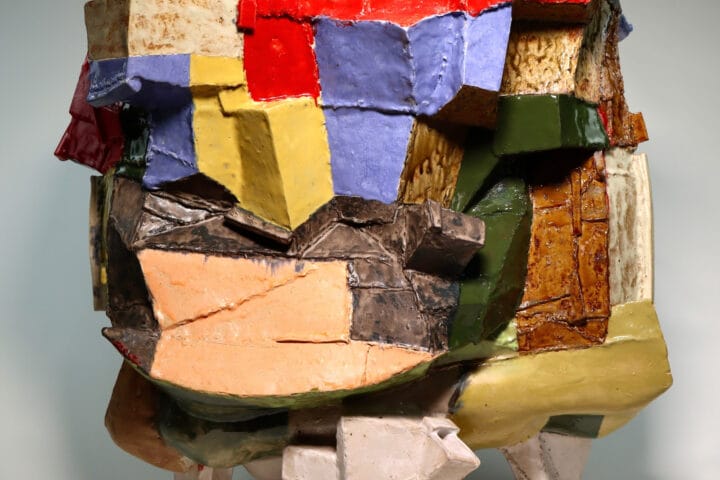Fine Lines is an exhibition dedicated to gallery artists who excel at drawing, usually on paper, using various mediums including ink, pastel, marker, and graphite. While their creations are unique, they all turn to art making for solace and life affirmation.
Joseph Lambert (Belgium b. 1950) drawings resemble at once handwritten letters, one line of thought superimposed upon the another, as well as geographic stratum. Script seem to squirm between rock, water and earth, all forming histories compressed in time. Like Lambert, Nazanin Tayebeh (Iran, b. 1993) also writes, but her missives are directed to an imaginary friend. Depending on the status of their friendship on any given day, she writes colorful organized tight-lined letters on a sharp diagonal slat, or explosive letters with quickly drawn lines breaking the ordered flow of her markings.
Mahmut Ozdemir (Turkey, 1949 – 2021) came from a small village near the sea of Marmara. He envisioned greatness for his town by imagining the building of architecturally fantastic stadiums that would draw an international audience. Waiting for this dream to become a reality, he ran a general store out of the front room of his house, picked figs, and told fortunes reading coffee grounds. Rubel Adrían Matos Chambrot (Cuba, b. 2003), is also fascinated by architecture. His precisely rendered, spired cities are connected building to building by untethered bridges. A single cityscape will often be inverted two or three times in the same drawing. Like Ozdemir and Chambrot, Evelyne Postic (France, b. 1951) is also concerned with place. For this exhibition she has drawn on old maps whose specific locales become partially obscured backgrounds for the fantastical life-forms that encapsulate our shared life cycle; birth, maturation, and death.
Taguchi Boss (Japan, b. 1945) and Loïc Lucas (France, 1966) both express fascination with biologic diversity. Boss prefers colorful drawings of life on a cellular level with protozoan-like forms morphing into half assembled creatures with multiple limbs, while Lucas limits his palate to three colors, and is more intent on human anatomy; branching alveoli nestle next to flowering fallopian tubes, small, still not completely formed hands spanning the two, all in mutual accord to their purpose—the sustainability of life force.
Sarvenaz Farsian (Iran, b. 1984) uses drawing as a meditative device. She creates highly detailed abstract drawings using a fine point pen. She states the moment I start drawing on a plain white surface is the moment of birth, and the moment I finish drawing is the loss of life. On this journey of life are joyful moments and of course severities, that are slowly interwoven into these meditations.
Mohammad Banissi (Iran, b. 9192) has been exhibited extensively in Iran and France since 2016. He takes particular inspiration from the paintings of Vincent Van Gogh, which he translates into luminous refracted abstractions using oil pastels.
Tomáš Malíček and Karel Pajma are Czech artists who have found stability and solace in their abstract artmaking. Malíček draws miniscule connected forms that create larger clusters which expand and contract on the paper. Pajma makes translucent geometric drawings that playfully experiment with the morphing of straight lines into curved lines.
Angkasapura (Indonesia, 1979) who grew up in animistic surroundings in Irian Jaya, always loved to draw. When he was 24 years old, he was visited by a supernatural being who told him to make art to keep Balance and sound moral judgment in his life. Every drawing he makes has the phrase KI RADEN SASTRO INGI which was said to him by the Spirit. He creates using found paper, pen, and pencils, and always his brilliant, improvisational creativity.










